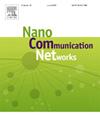Crosstalk analysis of multilayer graphene nanoribbon interconnects in GHz regime: Unraveling scattering induced effects
IF 4.7
4区 计算机科学
Q2 ENGINEERING, ELECTRICAL & ELECTRONIC
引用次数: 0
Abstract
This paper analyzes the impact of high-frequency phenomena on the operational characteristics of intercalation-doped horizontal top-contact multilayer graphene nanoribbon (D-HTC-MLGNR) interconnects. The purpose is to explore their viability for utilization in high-frequency circuit design. A methodology incorporating the scattering-limited realistic mean free path and a finite thickness-dependent skin effect model is proposed for extracting the frequency-dependent impedance of MLGNR interconnects. By employing the proposed methodology, the frequency-dependent characteristics of scattering-limited impedance parameters and crosstalk effects in d-HTC-MLGNR interconnects are examined and compared with undoped MLGNR (viz. HTC and vertical top-contact) and copper (Cu) counterparts (smooth and rough). The findings indicate that Cu variants outperform scattering-limited MLGNR variants placed on SiO2 substrate in terms of crosstalk effects. However, Li-doped HTC-MLGNR without surface polar phonons (SPPs) and edge roughness (ER) placed on SiC and BN substrates demonstrates superior crosstalk-induced performance than Cu counterparts. Furthermore, in the absence of SPPs and ER, Li-D HTC-MLGNR placed on SiC has a minimum average percentage increase in overshoot peak amplitude, overshoot width, and delay of 6.6%, 0.18%, and 15.6%, respectively, for the entire frequency range, implying minimum impact of frequency variations and skin effect.
千兆赫波段多层石墨烯纳米带互连的串扰分析:解解散射诱导效应
本文分析了高频现象对插层掺杂水平顶接触多层石墨烯纳米带(D-HTC-MLGNR)互连工作特性的影响。目的是探索它们在高频电路设计中应用的可行性。提出了一种结合散射限制的现实平均自由程和有限厚度相关的集肤效应模型的方法,用于提取MLGNR互连的频率相关阻抗。通过采用所提出的方法,研究了d-HTC-MLGNR互连中散射限制阻抗参数的频率依赖特性和串扰效应,并与未掺杂的MLGNR(即HTC和垂直顶接触)和铜(Cu)对口(光滑和粗糙)进行了比较。结果表明,Cu变体在串扰效应方面优于放置在SiO2衬底上的限制散射的MLGNR变体。然而,没有表面极性声子(SPPs)和边缘粗糙度(ER)的锂掺杂HTC-MLGNR在SiC和BN衬底上表现出优于Cu衬底的串扰诱导性能。此外,在没有spp和ER的情况下,放置在SiC上的Li-D HTC-MLGNR在整个频率范围内的超调峰值幅度、超调宽度和延迟的平均百分比增幅最小,分别为6.6%、0.18%和15.6%,这意味着频率变化和集皮效应的影响最小。
本文章由计算机程序翻译,如有差异,请以英文原文为准。
求助全文
约1分钟内获得全文
求助全文
来源期刊

Nano Communication Networks
Mathematics-Applied Mathematics
CiteScore
6.00
自引率
6.90%
发文量
14
期刊介绍:
The Nano Communication Networks Journal is an international, archival and multi-disciplinary journal providing a publication vehicle for complete coverage of all topics of interest to those involved in all aspects of nanoscale communication and networking. Theoretical research contributions presenting new techniques, concepts or analyses; applied contributions reporting on experiences and experiments; and tutorial and survey manuscripts are published.
Nano Communication Networks is a part of the COMNET (Computer Networks) family of journals within Elsevier. The family of journals covers all aspects of networking except nanonetworking, which is the scope of this journal.
 求助内容:
求助内容: 应助结果提醒方式:
应助结果提醒方式:


